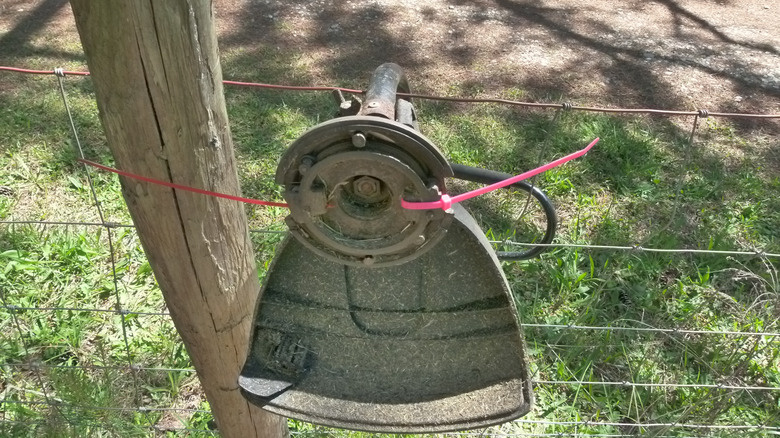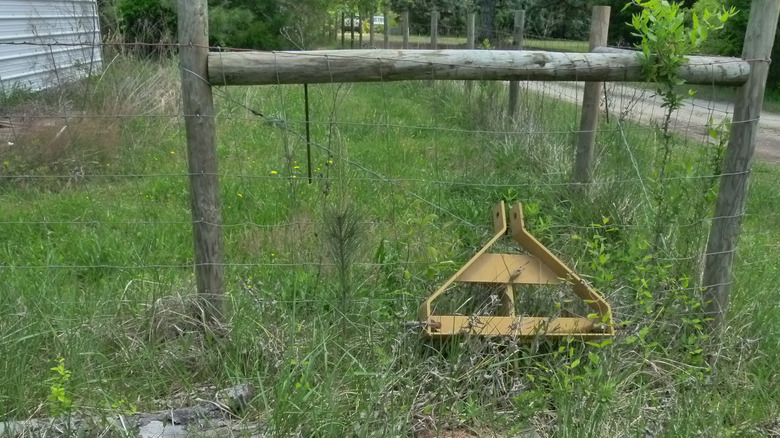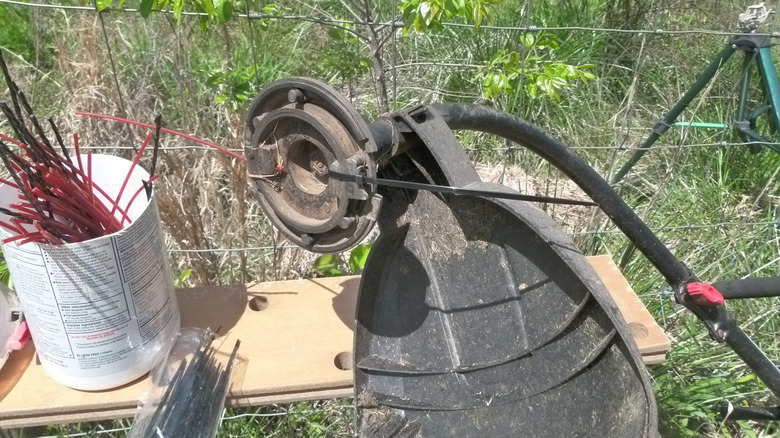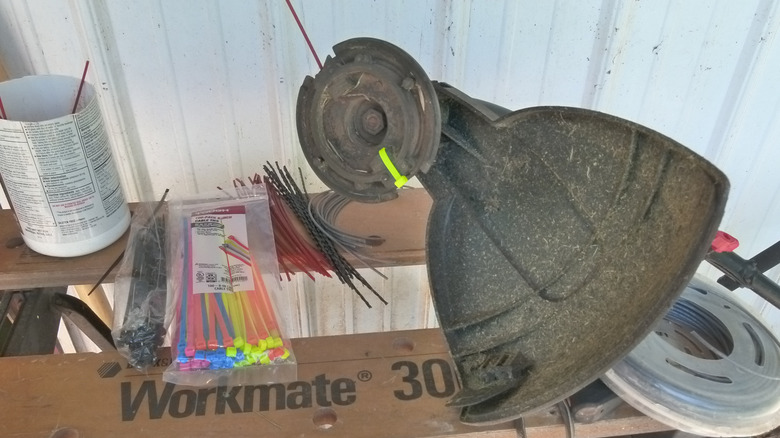Genius Hack Or A Waste Of Ties? We Tried TikTok's Viral Weed Eater DIY
When someone pointed me to @chrisgarage78's TikTok video showing him replacing weed eater string trimmer line with cable ties, I was skeptical. But the salient fact about string trimmer line, and string trimmers by extension, is that they're one of the most frustrating products in the world to use. So, almost any idea that subverts the dominant string trimmer paradigm is a revolution worth signing up for — or at least trying out. Could this be another for our ever-growing list of genius home and garage zip tie hacks?
It seems unlikely there's another product from which we would tolerate the failure rate of trimmer line (to say nothing of bump feed mechanisms that never seem to work after the first day). Yes, it's a consumable, and I realize that normal use against grass and weeds will also break trimmer line. But concrete driveways and foundations, wire fences, and the like are perfectly normal, predictable parts of a lawn, and a string trimmer line's inability to cope with it for more than a few seconds is a failure, full stop. Do I want to pay for more durable line and the stronger, more expensive trimmer you'd need to run it? No. I just don't want to constantly wrestle with a product that must be sold in 50- or 100-foot rolls even though you only use 8 inches at a time because it breaks so easily and so frequently.
Setting up a fair fight between the trimmer and the trimmed
My first pass at testing this hack involved some cable ties I had on hand, and it did not go well. I tend to buy cheap cable ties because I use a lot of them and rarely require great strength of them, but these weren't up to the job. I went to Walmart and bought a pack of 100 Hyper Tough 8-inch cable ties for $5.87 (8.8 cents per foot) that claimed a tensile strength of 75 pounds per foot. That's slightly more expensive per foot than a common brand of .095-omch trimmer string, which costs 8.0 cents per foot for 50 feet of trimmer line and 7.5 cents per foot for 100 feet. Walmart doesn't publish the lines' tensile strengths, but YouTube's Project Farm did a comparison of .095-inch lines a few years back and found an average tensile strength of 170.5 pounds. The original cable ties I tried measured 3.58 x .95 millimeters, while the new Walmart cable ties measured 4.65 x 1.25 millimeters.
Rather than actually measuring the strength of the cable ties and trimmer line, my strategy was to use a bit of trimmer line and a cable tie at the same time (I'll explain below) and note how they compared as I carried out common trimming tasks. This should give me the degree to which cable ties are a good replacement, instead of meaningless measurements. I would be using a gas-powered trimmer, usually considerably slower than even budget weed eaters, which often perform well.
Game day: testing string trimmer line against cable ties
I had on hand four brands of .095-inch trimmer line in red, black, and gray. The Hyper Tough cable ties came in four colors (orange, pink, yellow, and blue), so I color-coded by task. Orange denoted plants only, pink was for cutting against a fence, yellow was for cutting against concrete, and blue wasn't used. There's a remote part of our property with a former garden area and lots of field fencing, and that's where my little experiment began.
I use an ancient gas trimmer with an older fixed-line style of string trimmer head that holds two 8-inch lengths of line at a time. When the line breaks, you pull the stub out, clamp in a new segment, and carry on. The idea was this: For grass, load the trimmer head with red line and an orange cable tie, and replace the cable tie whenever it broke. When the trimmer line broke I'd change to black, then to gray. Once the gray line was finished, the experiment was concluded and I would repeat the process for fencing, then for concrete.
The TikTok comments are overrun with two opposite types of people: those who think the cable ties break too easily and might hit you, and those who use metal wire instead and apparently aren't bothered by the prospect of .121-inch bailing wire ejecting from your weed eater at 7500 rpm. The former commenters were right. I was well on my way to a 100:1 ratio for grass alone when I gave up and moved on to the fenceline, which was worse — as was concrete.
A waste of (otherwise) perfectly good cable ties
I've long had a notion that goes something like this: Materials engineers are for when you want to under-engineer something; use a DIYer if you want the thing over-built and bomb-proof. This might often be true, but it's certainly not true in this case. The DYI trimmer line engineering was an utter failure. I think the issue is ductile strength, not tensile strength. When you watch slow-motion videos of trimmer line in action, you see that it stretches, bends, and deforms as it cuts, and from the clean breaks in the cable ties, I gather they don't have that flexibility. The cable ties are simply too brittle for this purpose.
It's possible that other, presumably more expensive brands would perform better, but since the cable ties are already more expensive than trimmer line, there seems to be little point. Might pricier cable ties work in a pinch? Maybe. If you've somehow exhausted all of your trimmer line, you can get away with cable ties for a little while. But it's better to not let that happen; I personally own at least four spools of the stuff, and so can't imagine a scenario where I'd run out unexpectedly. Perhaps more to the point, it's hard to imagine anything you could reasonably describe as a string trimmer emergency. If you run out of line, put the weed eater back in the shed and pick up more line on the way home from work Monday. The alternative is to use a bunch of pricey cable ties that will make the most frustrating tool you own even more irritating to use.



